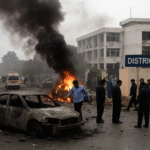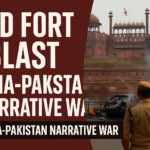In recent months, whispers of a new Doha-style peace framework between Pakistan and Afghanistan have resurfaced. For Islamabad, such an accord represents more than diplomatic symbolism — it’s an urgent bid to stabilize its western frontier, reduce cross-border terrorism, and reset ties with a Taliban-ruled Kabul that has grown unpredictable.
For Afghanistan, meanwhile, dialogue with Pakistan is a strategic necessity. The Taliban government, still struggling for global legitimacy and economic breathing space, understands that a perpetually hostile border threatens its survival as much as Pakistan’s security.
Yet history weighs heavily. Each attempt at reconciliation — from the Murree Talks of 2015 to post-2021 security dialogues — has collapsed under the strain of mistrust, competing agendas, and militant spoilers. A “Doha Peace 2.0”, therefore, faces the same question: Can two neighbours bound by geography but divided by suspicion truly rebuild trust?
1. Why Pakistan Seeks a New Understanding
Pakistan’s interest in reviving structured peace talks with Kabul stems from a convergence of strategic, security, and economic imperatives.
Security Imperative
Since the Taliban’s takeover in August 2021, terror incidents in Pakistan have surged, with the Tehrik-e-Taliban Pakistan (TTP) claiming responsibility for dozens of attacks. Islamabad believes many of these militants operate from safe havens inside eastern Afghanistan, exploiting the porous border and tribal networks.
The Pakistani state — having lost over 80,000 lives to terrorism in the past two decades — views a renewed peace mechanism as essential to halt this trend. A ceasefire framework, cross-border verification system, and Kabul’s public commitment not to host anti-Pakistan elements could serve as the foundation for sustainable security.
Economic and Political Logic
Pakistan’s fragile economy adds urgency. Border instability disrupts trade routes, foreign investment, and transit connectivity projects. A peaceful western border could unlock new corridors for Central Asian connectivity, allowing Pakistan to reposition itself as a regional trade hub.
Moreover, Islamabad faces political pressure at home to show tangible progress. With the IMF deal providing temporary financial relief, the government knows long-term stability depends on regional calm — not perpetual conflict. A peace deal thus carries both strategic and political dividends.
2. Afghanistan’s Stakes and Constraints
For the Taliban government, a peace accord offers a different but equally important prize — legitimacy.
Quest for Recognition
Two years after seizing power, the Taliban regime remains diplomatically isolated. A working security agreement with Pakistan, potentially brokered by Qatar or Turkey, could showcase the Taliban’s willingness to act like a responsible state rather than a militant movement. That perception shift could encourage selective international engagement and aid.
Internal Factional Pressures
Yet the Taliban leadership is far from monolithic. Power is divided between the Kandahar-based “Akhundzada camp” and the Haqqani faction headquartered in Kabul. Each has its own networks, tribal loyalties, and worldviews.
For the Kandahar faction, showing deference to Pakistan risks appearing weak; for the Haqqanis, it risks alienating their domestic rivals. The Taliban’s balancing act — between ideology, nationalism, and survival — makes any firm commitment to Pakistan’s security demands deeply complicated.
Governance and Capacity Gaps
Even if Kabul intends to prevent militants from using Afghan soil, its capacity to enforce such control is limited. The border terrain, weak institutional policing, and overlapping tribal loyalties mean enforcement requires cooperation — not just promises.
3. The Haqqani Factor: From Pakistan’s Favourite to Frustration
For decades, the Haqqani Network (HN) stood as Pakistan’s most trusted ally within the Taliban movement. Its leadership — first Jalaluddin Haqqani and later his son Sirajuddin Haqqani — cultivated deep ties with Pakistan’s intelligence community and military establishment. Many in Islamabad saw the network as a reliable instrument to shape Afghan outcomes and counter Indian influence.
However, after 2022, that confidence began to erode. The very network once viewed as Pakistan’s “strategic asset” failed to safeguard Islamabad’s interests in the new Afghan order.
Autonomy and Diverging Agendas
The Haqqanis operate semi-independently within the Taliban structure, controlling their own funding, intelligence networks, and tribal bases. Once Sirajuddin Haqqani became Afghanistan’s Interior Minister, his priorities shifted from insurgency to governance. He had to maintain internal legitimacy — not appear as Pakistan’s enforcer.
As a result, Pakistan’s expectation that the Haqqanis would curb TTP activity or pressure Kabul to hand over wanted militants collided with Haqqani’s own political survival inside the Taliban regime.
Rise of Anti-Pakistan Sentiment
By 2023–24, the Kandahar faction began consolidating power. Nationalist rhetoric framing Pakistan as a “meddling neighbour” gained ground. Reports suggest Haqqani influence was curtailed as Kandahar-based hard-liners took over key ministries. With that, Pakistan’s once-trusted channel lost much of its weight in Kabul.
Failure to Deliver on Core Interests
Despite repeated meetings and back-channel diplomacy, the Haqqanis could not prevent cross-border TTP attacks nor convince the Taliban leadership to act decisively. Limited operational control, shared ideological roots, and tribal affinities made enforcement nearly impossible.
By late 2022, Islamabad’s frustration was visible. The perception grew that the Haqqani bridge to Kabul had collapsed, leaving Pakistan without an effective lever in Afghan politics.
The lesson was clear: proxies evolve, but patronage fades. The Haqqanis’ transformation from insurgent allies to government power-brokers changed their calculus — and Pakistan’s influence over them.
4. India’s Strategic Lens: Watching, Waiting, and Leveraging
Whenever Pakistan and Afghanistan move toward rapprochement, India watches closely. For New Delhi, the Taliban’s control in Kabul remains a double-edged sword — a potential source of instability, but also an opportunity to erode Pakistan’s regional depth.
Diplomatic and Development Footprint
India was among the first to quietly reopen its embassy in Kabul in 2022. Since then, it has expanded humanitarian aid, reconstruction projects, and educational outreach — all designed to re-establish goodwill and intelligence access.
If Pakistan-Afghanistan relations stabilize, India stands to lose influence. But if tensions persist, New Delhi gains room to manoeuvre — using diplomatic engagement, intelligence outreach, and soft-power projection to keep Pakistan’s western flank unsettled.
Strategic Calculation
India’s broader aim is to prevent any Pakistan-Taliban alignment that might free Islamabad to focus entirely on its eastern border. Hence, New Delhi’s best outcome is a controlled instability — one that doesn’t collapse into chaos but keeps Pakistan diplomatically stretched.
In that sense, India won’t sabotage peace talks overtly, but will likely exploit every delay or breach to advance its narrative of Taliban unreliability and Pakistan’s limited control.
5. The TTP Wildcard — Peace’s Greatest Saboteur
No peace framework can survive if the Tehrik-e-Taliban Pakistan (TTP) remains unchecked. Since 2022, the group has re-emerged as the most lethal anti-Pakistan threat, targeting security convoys, police stations, and border posts.
The Taliban’s Dilemma
Ideologically and tribally, the TTP is intertwined with the Afghan Taliban. Many of its members fought alongside them against the U.S. The Taliban government fears that a full-scale crackdown on the TTP could spark internal rebellion or drive militants toward Daesh-Khorasan, an even greater security risk.
Pakistan’s Stance
Pakistan has made its position clear: “No peace without security.” It demands that the Taliban disarm, expel, or neutralize TTP fighters operating from Afghan soil. Yet every time pressure builds, Kabul calls for dialogue, urging Pakistan to “understand” the TTP’s grievances — a stance Islamabad views as disingenuous.
Military and Diplomatic Leverage
Faced with rising casualties, Pakistan has responded with selective cross-border strikes and intelligence-based operations. Diplomatically, it is pressing regional players — especially China, Qatar, and the OIC — to nudge Kabul toward compliance.
Still, the TTP issue remains the most serious test for any Doha 2.0 agreement. Without a credible mechanism to curb its attacks, no peace accord can hold for long.
6. Pakistan’s Core Demand — “No Terror from Your Soil”
At the heart of every Pakistani proposal lies one consistent line:
“Afghanistan must ensure its territory is not used for terrorist activities against Pakistan.”
How This Demand Could Be Fulfilled
To make it real, Islamabad proposes a structured framework based on five pillars:
1.Joint Verification Mechanism:
A bilateral security commission, co-chaired by both states and supported by a neutral observer (Qatar, Turkey, or UN), to investigate cross-border attacks.
2.Intelligence-Sharing Hotlines:
Real-time channels between Pakistan’s ISI and Afghanistan’s General Directorate of Intelligence (GDI) for pre-emptive coordination.
3.Border Management Cooperation:
Enhanced fencing, synchronized patrols, and technology-assisted checkpoints to reduce militant movement.
4.Economic Incentives for Compliance:
Pakistan could expand transit access, energy trade, or aid delivery if Kabul verifiably prevents TTP infiltration.
5.Regional Support Structure:
Encourage China, Qatar, and Saudi Arabia to endorse and monitor implementation — adding weight to commitments.
Why Full Compliance Is Difficult
Even with goodwill, enforcement is hard. Kabul’s limited resources, rugged terrain, and competing factions mean violations will occur. But if there’s a credible response mechanism — investigation, accountability, and compensation — the overall deterrent effect could still work.
7. The Road Ahead — Trust-Building or Tactical Pause?
A new Doha-based peace deal, if achieved, will buy both states valuable breathing space. Pakistan will gain time to refocus its internal counter-terror operations, and the Taliban can showcase diplomatic maturity to the world.
Yet history warns that such truces often amount to tactical pauses, not transformations. Without structural verification and sustained incentives, mistrust can resurface rapidly.
The key lies in institutionalization — regular joint commissions, transparent reporting, and third-party observation. Peace cannot rest on personalities alone; it must be process-anchored and monitored.
Conclusion — A Fragile Hope in the Hindu Kush
A new Doha Peace 2.0 offers Pakistan and Afghanistan an opportunity to rewrite decades of hostility. Both nations stand to gain from stability — Pakistan through economic revival and security relief, and Afghanistan through legitimacy and trade.
But the pathway is steep. The Haqqani Network’s decline has removed Islamabad’s most trusted channel inside Kabul. India’s subtle diplomacy and the TTP’s continued violence remain active spoilers.
Ultimately, peace will depend not on grand summits, but on day-to-day cooperation, credible enforcement, and political will. Only if Kabul truly acts to prevent the use of its soil for terror — and Pakistan matches firmness with patience — can both nations turn the page from suspicion to partnership.
Otherwise, “Doha 2.0” risks becoming yet another fragile chapter in the long, turbulent story of the Hindu Kush.










